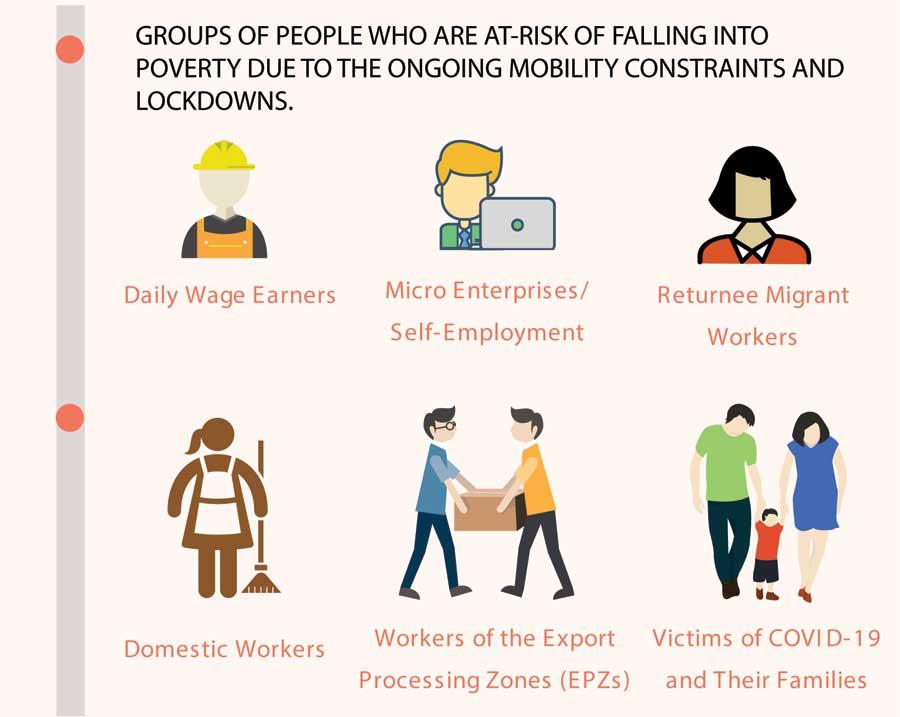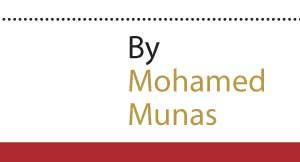Reply To:
Name - Reply Comment
Last Updated : 2024-04-19 08:50:00

Crisis situations such as COVID 19, exacerbate existing inequalities and vulnerable even more susceptible. The very same physical and social contacts that sustain our societies have become life-threatening. Identifying those at-risk, in situations that are in a constant state of flux, shaped by past socio-economic ruptures, is challenging. Within such a reality, are we learning fast enough to provide the necessary support at the household level, and to ensure that the at-risk groups in our society are taken care of? What should we consider as evidence to ensure that the most at-risk are taken care of?
 The key question here is what kind of people are highly vulnerable during the COVID-19 pandemic when such continuous restrictions are placed? To analyse this, we briefly look at the discussions, measurements and identification around poverty and vulnerability.
The key question here is what kind of people are highly vulnerable during the COVID-19 pandemic when such continuous restrictions are placed? To analyse this, we briefly look at the discussions, measurements and identification around poverty and vulnerability.
We find that the existing data on the spatial distribution of poor in Sri Lanka is inadequate as the COVID-19 outbreak has created a shift in this discourse and some new categories of that at-risk enter the horizon of ‘poor’. This complexity calls for careful re-thinking of categories that are identified as poor, within the new situation.
Nature of poverty in urban, rural and estate sectors
As per monetary poverty, measurement figures determined by the Department of Census and Statistics (DCS), the highest concentration of the poor is in the estate sector with 8.8% living under the poverty line, earning a monthly income of less than Rs.4,166 per person. The percentage of poor in rural areas is higher compared to the urban sector, 4.4% and 1.9% respectively. Importantly, a significant proportion of people who live just above the poverty line, are considered “not poor”.
People in this group are likely to fall into poverty due to loss of income caused by external shocks.A10% increase in the poverty line can increase the absolute numbers of the poor from 843,913 to 1,255,702. When it comes to the urban and suburban poor, the impact of shocks could be even more sensitive given the presence of the high number of absolute poor in these areas.
This COVID-19 situation disproportionately affects the people who are vulnerable to poverty in addition to the people who are already poor. As per the recent directive by the President, the government identified persons with disabilities, senior citizens, farmers, expectant mothers and their families, Samurdhi recipients, pensioners, the self-employed, and micro and small businesses as main categories to be assisted with financial and non-financial benefits in an attempt to combat the COVID-19 impact on the poor. A major concern is that a large proportion of non-contractual/informal workers fall through the cracks of this categorisation. Access to such vulnerable groups is further compounded by the absence of databases and verifiable data that could support the government and non-governmental development practitioners to extend support. The availability of such databases would have facilitated the smooth and transparent functioning of such cash transfer programmes minimising space for patron-client relationships.
Despite high levels of poverty, the rural population is more resilient to shocks caused by COVID-19, in food security, as they produce food which can be utilised for self-consumption. Agriculture based communities can cope better than others since food production is allowed to continue during the curfew and encouraged by incentives such as increasing local demand for food, import restrictions, subsidies, tax relief and guaranteed prices. However vulnerable groups such as the landless, displaced, recently resettled and geographically isolated within the rural population should be identified and supported. Further, the inability to access agriculture fields following the recent ‘isolation’ of rural villages that survive on crop agriculture, may mean that such rural livelihoods are seriously compromised and these groups will need immediate and longer-term support.
Income sources and livelihoods of low-income groups who are living and working in urban areas have become almost non-existent due to the suspension of related economic activities.
Daily wage earners: Although, daily wage earners are classified into one group, their inter-group differences are masked when clustered together. This group may consist of people with varying income, working in a range of sectors such as construction, sales personnel, tourism, transport, manufacturing, cleaning and health services sector. Most of them dwell in low-income urban settlements, suburbs and under-served settlements which barely provides resources or opportunities to produce for consumption.
Transport providers: One of the most popular income-earning opportunities for the urban areas is the provision of transport services, using smaller vehicles such as motorbikes, tuk-tuks, budget cars and small trucks. A portion of this group benefited from the growing economy and platform-based operations such as Uber and PickMe which expanded to capture the opportunities provided by the platform economy during curfew, in the urban areas. However, the concentration of these private services to urban areas restricts the spatial distribution of their benefits.
Street vendors: One of the least understood and acknowledged, but worst hit groups, given the current restrictions on movement are street vendors. They become very visible during festive times and the traditional holiday periods provides income opportunities for many poor families. The income generated during these months would act as a buffer for the rest of the year. Therefore, the absence of this income will be acutely felt by families dependent on street markets, in the medium term.
Domestic workers: By some estimates, there are over 87,000 individuals employed as domestic workers, with some paid every month and others daily.They are not assured of continuous pay when they are absent or on leave for too long.This category has very limited social protection. Domestic workers who are paid daily are even more vulnerable due to limited mobility and the lack of work.
Returnee migrant works: Considering the high volume of labour flow overseas for work (official numbers indicate approximately 200,000 migrate for work annually from Sri Lanka), there is a sizeable returnee population in Sri Lanka in any given point of time. While national-level data is lacking, it is generally acknowledged that a good proportion of this population returns with the expectation of going back to workplaces overseas, which the shutdown does not allow. Self-employment is a common economic integration strategy used by these returnees when they permanently return which is not a reality in the current context.
Workers of the Export Processing Zones (EPZs): The workers confined in the export processing zones that are primarily located in the urban heartland has drawn the attention of the media and the government. As the EPZs absorb a significant proportion of their workforce from the rural areas, internal migrant workers are also at risk of losing their stable monthly incomes. The more difficult to trace would be those young men and women who seek out work opportunities daily through Manpower Agencies, home-based workers and who are now left with no access to such daily wage work arrangements.
The socially stigmatised and marginalised: There are many categories of people who are made invisible due to cultural norms. As a result, the LGBTQ community, those imprisoned and commercial sex workers are not “counted.” However, these groups are legally protected by the constitution and are entitled to equal rights.
Victims of COVID-19 and their families: While considering the difficulties of other categories mentioned above, these victims go through another traumatic experience created by social stigma. Social taboos, loss of dignity and respect, shame, feelings of discrimination and isolation are psychosocial factors that would far outlive the COVID-19 pandemic and would lead to the creation of new categories of vulnerabilities. Although the monetary aspect of poverty is attractive for decision-makers, attention to these hidden and missing dimensions of poverty is critical.
What we are facing right now is unprecedented and affects the entire population of Sri Lanka. The fear of the disease and its ability to infect across all social distinctions of class, gender, age, ethnicity, sexuality, social/economic/political power, ironically exemplifies the vulnerability of the “human”. However, the coping abilities of different groups, to face wider impacts of COVID 19, will differ based on a range of factors.
“Having food on the table” is a challenge for many families. Nutrition levels may plummet and many are worried, stressed, and suffer from anxiety. Despite relatively strong social networks, especially away from the urban centres, restricted mobility will require creating means of reaching out to those in need and may take time to materialise.
With no access to unemployment benefits, vulnerable groups lack a buffer during these difficult times, further exacerbating their inability to survive a lockdown. While acknowledging that the categories described above are not all-inclusive and comprehensive, there is an urgency to look beyond the already identified ‘poor’ groups listed by the government and policymakers. Further, this situation may push us to refine the methodologies used to identify, define and estimate poverty in Sri Lanka.
We also need to take into account the fact that the COVID-19 pandemic will create and leave behind health-related, economic, social and political impacts, which will have to be taken up at policy and action level as part of the strategy to face this crisis successfully. Therefore, as we strategise to ‘flatten the curve’ of COVID-19 infections, we should strategise to ‘flatten the curve’ of physical, social, economic and political risks, that will result from COVID-19, starting from now. What we should be looking at is a new socio-economic and political order.
The writer is a Senior Researcher at the Centre for Poverty Analysis (CEPA) and a PhD Candidate at the Radboud University, Netherlands.

Add comment
Comments will be edited (grammar, spelling and slang) and authorized at the discretion of Daily Mirror online. The website also has the right not to publish selected comments.
Reply To:
Name - Reply Comment
On March 26, a couple arriving from Thailand was arrested with 88 live animal
According to villagers from Naula-Moragolla out of 105 families 80 can afford
Is the situation in Sri Lanka so grim that locals harbour hope that they coul
A recent post on social media revealed that three purple-faced langurs near t

10 Apr 2024
09 Apr 2024